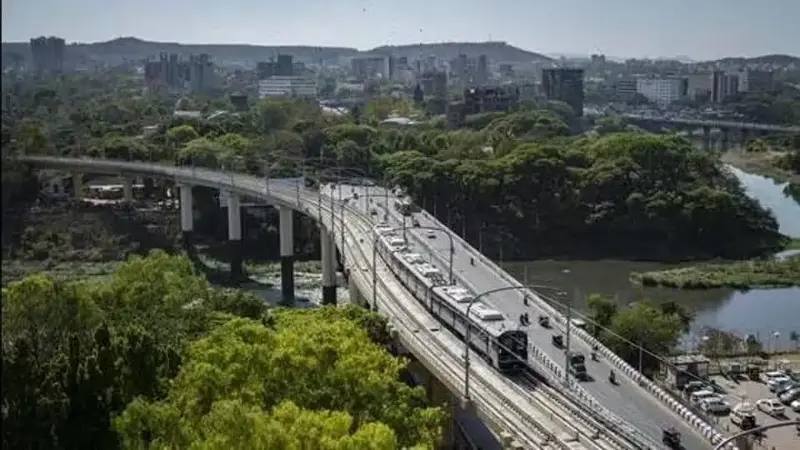
The Union Cabinet, chaired by Prime Minister Narendra Modi, has given its nod for the Pune Metro rail network expansion, Information and Broadcasting Minister Ashwini Vaishnaw announced on 26 November.
According to an official release from the Centre, the latest approval makes way for the Pune Metro network to expand beyond the 100-km milestone, and is a “significant step towards a modern, integrated and sustainable urban transit system”.
This is the second major project approved under Phase-2 of the Pune Metro. Earlier, Line 2A for the Vanaz–Chandani Chowk route, and Line 2B for the Ramwadi–Wagholi/Vitthalwadi route, was approved.
Pune Metro expansion: Which lines and stations will be added?
As per the release, the newly approved lines are Line 4 and Line 4A under Phase-2 of the Pune Metro Rail Project.
- Line 4 will include the Kharadi–Hadapsar–Swargate–Khadakwasla stations.
- Line 4A will include Nal Stop–Warje–Manik Baug stations.
- Daily ridership on combined Line 4 and 4A is expected to be around 4.09 lakh in 2028, and estimated to rise to nearly 7 lakh in 2038, 9.63 lakh in 2048 and over 11.7 lakh in 2058, as per the release.
- The Kharadi–Khadakwasla corridor in particular is estimated to ferry 3.23 lakh passengers in 2028, growing to 9.33 lakh by 2058.
- While estimates showed the Nal Stop–Warje–Manik Baug spur line will rise from 85,555 passengers in 2028 to 2.41 lakh passengers by 2058, it said.
What is the timeline and total expansion for Pune metro?
- For a total of 28 stations, the 31.636 km Line 4 and 4A will connect IT hubs, commercial zones, educational institutions and residential clusters across East, South and West Pune, as per the release.
- It added that the project will be completed within five years at an estimated cost of ₹9,857.85 crore.
- Funding will be jointly shouldered by the Centre, Maharastra government and external bilateral / multilateral funding agencies.
- The project will be implemented by Maharashtra Metro Rail Corporation (Maha-Metro).
- Maha-Metro will also carry out all civil, electrical, mechanical and systems works.
Why is this decision significant?
The approval comes as Line 4 and 4A are considered a “vital part” of Pune's comprehensive mobility plan (CMP). Once completed, the release said the lines will “seamlessly integrate with operational and sanctioned corridors at Kharadi Bypass and Nal Stop (Line 2), and Swargate (Line 1)”.
“They will also provide an interchange at Hadapsar Railway Station and connect with future corridors towards Loni Kalbhor and Saswad Road, ensuring smooth multimodal connectivity across metro, rail and bus networks,” it added.
Pre-construction activities such as topographical surveys and detailed design consultancy are already underway.
Two rail projects worth ₹2,781 crore approved for Gujarat, Maharashtra
Meanwhile, the Cabinet has also approved doubling of the Dwarka-Kanalus rail line in Gujarat; and building third and fourth lines between Badlapur and Karjat in the Mumbai metropolitan region (MMR).
The two projects are estimated to cost ₹2,781 crore, Vaishnaw, who is also Union Railways Minister, told reporters during his briefing.
- The Devbhumi Dwarka (Okha)-Kanalus rail line will improve connectivity to the Dwarkadhish temple, a key pilgrimage site, and transportation of commodities such as coal, salt, container, and cement.
- And capacity augmentation works will result in additional freight traffic of magnitude 18 MTPA (million tonnes per annum).
- The Badlapur-Karjat section will improve the connectivity in MMR and meet the future demands of passengers, besides providing connectivity to southern India, he added.
Key Highlights: What are the benefits?
The official release noted that the two projects covering four districts across the states of Maharashtra and Gujarat, will increase the existing network of Indian Railways by about 224 kms, and enhance connectivity to about 585 villages (population of around 32 lakh).
“The Railways, being environment friendly and energy efficient mode of transportation, will help both in achieving climate goals and minimising logistics cost of the country, reduce oil import (3 crore litres) and lower CO2 emissions (16 crore kg) which is equivalent to plantation of 64 lakh trees,” the statement added.
